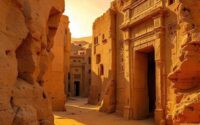The Sphinx’s Missing Riddle
The Great Sphinx of Giza doesn’t speak, yet it’s posed humanity’s greatest puzzle for millennia. While mythology credits sphinxes with riddles, Egypt’s colossal guardian remains silent—no inscriptions, no texts, no clues about its true purpose. Archaeologists can’t agree who built it or why. This 240-foot limestone sentinel guards secrets that modern technology still can’t reveal. What the ancients knew about this monument vanished with them.
Introduction

Why does one of history’s most iconic monuments remain shrouded in mystery despite centuries of study? The Great Sphinx of Giza has captivated archaeologists and tourists alike, yet it’s withholding vital secrets about its origins and purpose. While scholars’ve dated it to approximately 2500 BCE during Pharaoh Khafre’s reign, they can’t definitively prove who built it or why.
The limestone colossus guards more than just the Giza plateau. It protects answers to fundamental questions about ancient Egyptian civilization. Recent geological studies‘ve challenged traditional dating methods, suggesting the monument might predate the pyramids themselves. Advanced scanning technology’s revealed hidden chambers beneath the Sphinx, but excavation restrictions prevent full exploration. Each discovery raises more questions than it answers, transforming this ancient guardian into archaeology’s most tantalizing puzzle.
Ancient Egyptian Construction Date
Although mainstream Egyptologists confidently date the Sphinx to Pharaoh Khafre’s reign around 2500 BCE, they’re relying on circumstantial evidence rather than direct proof. The monument bears no inscriptions identifying its builder or construction date. Archaeologists link it to Khafre primarily because it sits near his pyramid and causeway, and a stela erected between its paws mentions his name—though this stone dates from 1400 BCE, over a millennium later.
The Sphinx’s head resembles statues of Khafre, but facial recognition technology hasn’t produced conclusive matches. Some researchers point to the monument’s architectural alignment with Khafre’s pyramid complex as supporting evidence. However, critics note that proximity doesn’t guarantee contemporaneous construction. The dating controversy intensifies because the Sphinx lacks the typical pharaonic cartouches and dedicatory texts that mark other monuments from this period.
Notable Cases or Sightings

The debate over the Sphinx’s age has sparked numerous investigations by researchers who’ve documented puzzling features that don’t fit the conventional timeline. Geologist Robert Schoch’s 1990s examination revealed deep vertical erosion patterns on the Sphinx’s body that he attributed to prolonged rainfall, suggesting construction predated 5000 BCE. John Anthony West’s earlier observations supported this water erosion hypothesis, noting the monument’s weathering differed dramatically from nearby structures.
In 1993, seismographic studies detected anomalous cavities beneath the Sphinx, though Egyptian authorities haven’t permitted extensive excavation. Frank Domingo’s forensic analysis compared the Sphinx’s face to known statues of Khafre and found significant discrepancies in facial proportions. These findings have fueled ongoing debates about whether the monument’s original construction preceded dynastic Egypt by thousands of years.
Common Theories or Explanations
While mainstream Egyptologists maintain the Sphinx was carved around 2500 BCE during Khafre’s reign, alternative researchers have proposed several competing theories about its origins. Geologist Robert Schoch argues water erosion patterns indicate the monument’s far older, possibly dating to 10,000 BCE when Egypt experienced heavier rainfall. This theory suggests an advanced pre-dynastic civilization built the structure.
Others believe the Sphinx’s head was recarved from an original lion’s head, explaining its disproportionate size relative to the body. Some researchers claim astronomical alignments point to construction dates matching ancient star configurations. Edgar Cayce’s followers insist there’s a hidden chamber beneath the monument containing Atlantean records. While these theories lack archaeological consensus, they’ve sparked ongoing debates about humanity’s ancient past and the possibility of lost civilizations predating recorded history.
Frequently Asked Questions
What Archaeological Methods Are Used to Search for Hidden Chambers Beneath the Sphinx?
Archaeologists use ground-penetrating radar to scan beneath the Sphinx, while seismic surveys map underground structures. They’ve also employed electrical resistivity imaging and endoscopic cameras through existing holes to detect potential voids and hidden chambers.
How Much Would a Full Restoration of the Sphinx Cost Today?
Experts estimate a complete restoration of the Great Sphinx would cost between $10-20 million today. They’d need to address erosion damage, replace missing stones, and stabilize the structure’s foundation while preserving its historical integrity.
Are Tourists Allowed to Touch or Climb on the Sphinx?
No, tourists can’t touch or climb the Great Sphinx. Egyptian authorities strictly prohibit physical contact to protect the ancient limestone structure from damage. Visitors must observe from designated viewing areas behind barriers at safe distances.
What Specific Limestone Quarries Provided Materials for the Sphinx’s Construction?
The Great Sphinx’s limestone came from the Mokattam Formation quarries directly on the Giza Plateau itself. Builders carved it from the same bedrock that’s beneath it, using stone layers that’d already existed at the construction site.
Which Museums Display Artifacts Directly Connected to the Sphinx?
The Egyptian Museum in Cairo displays the Sphinx’s beard fragment and Dream Stele. The British Museum holds another beard piece. The Louvre exhibits sphinxes from nearby temples. Boston’s MFA showcases related Fourth Dynasty artifacts.


